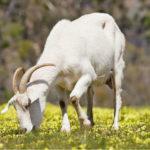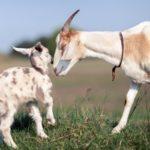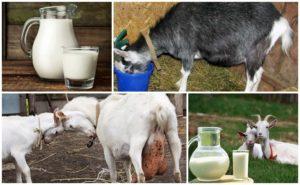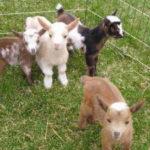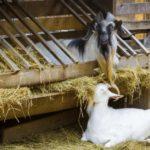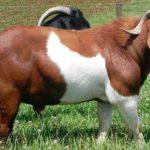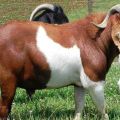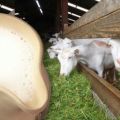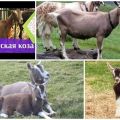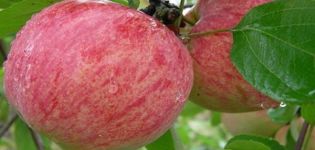What a goat should look like, a general description and varieties of breeds and how to choose
When buying a pet, you need to know what a healthy goat looks like. After all, there is no point in buying a sick or old individual. Goats are bred for milk, meat or wool (down). The productivity of animals depends on age, health and feed. Goats live up to 15 years. True, the peak of their productivity falls at 5 years of age. Older animals are usually slaughtered or sold on the market.
General description of the animal
The goat is a domestic animal of the class mammals and of the genus - mountain goats. Its ancestor is considered to be the bezoar goat. True, other representatives of this genus (alpine, horned) also participated in the creation of various breeds.
In ancient times, these animals lived in southern and western Asia, in the steppe, desert and wooded regions. They were domesticated many thousands of years ago. Currently, they are bred in different parts of the world. All European domestic goats are descended from Asian ancestors. Animals are raised for meat, milk, wool, fluff, skins.
Domestic goats reach a height (at the withers) of 0.5-1 meters. The length of the body is 0.6-1.2 m plus a tail of 10-20 cm. The weight of the animal, depending on the breed, is 25-130 kilograms. Goats have a narrow, angular exterior. Legs - straight, strong, with hooves. The body is covered with short or long hair. Color - white, black, brown, red, spotted.
Animals have a beard (both sexes), horns (longer for males). Only females of dairy breeds have outgrowths on the neck - earrings.
Males have a very pungent smell during the breeding period. Goats with dark hair smell stronger than goats with white. Animals mate willingly. Goats reach sexual maturity at 5-8 months. True, they are allowed to mate at 1-1.5 years. Pregnancy in females lasts 5 months. They usually give birth to 1-4 cubs, which are fed with milk for up to 3 months.
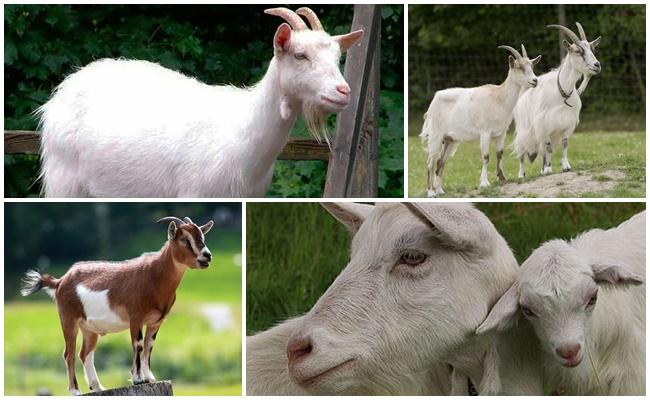
After lambing, the goats begin to milk. They give 1-5 liters of milk per day. The udder in females consists of two lobes. It has 2 or 4 nipples. The udder is pear-shaped or bowl-shaped. Females are covered annually to prolong lactation. The productive period is 7-9 years. These animals are in excellent health. They are immune to plague, scabies, and rarely get sick with tuberculosis. At 3 months of age, they are vaccinated against anthrax, brucellosis, foot and mouth disease, rabies, parasites.
It is also beneficial to breed goats because they eat less than cows. True, their productivity is lower than that of cattle. The diet consists of grass in summer and hay in winter. As a top dressing they are given vegetables, grain mixtures, branches of trees and bushes.
Varieties of goat breeds
The animals are mainly bred for milk, meat, fluff and wool. A huge number of breeds have been bred.Every corner of the world has its own species, which is best adapted to living in a particular area.
Dairy
In our area, mainly Alpine dairy goats are bred. These include: Saanen, including Russian White or Gorky, as well as Toggenburg, Appenzell, French, British or Italian Alpine. There are other dairy breeds: Megrelian, Spanish, Nubian, Maltese.
All goats of this type give 2-5 liters of milk with 3-6% fat per day. Productivity per year - 500-700 kilograms. The record holders give up to 8 liters of milk per day. These animals weigh about 50-60 kilograms. They are kept only for 7-9 years, at an older age, milk yield falls.
Meat
Meat goats differ from dairy goats in that they quickly gain weight. Kids are born weighing 4 kilograms. They eat, like all ruminant pets, grass and hay. By 10-12 months, they weigh over 100 kilograms. The most common beef breeds are Boer and Kiko. True, in our area they are rarely bred because of the high cost of breeding individuals (1-1.5 thousand dollars).
Woolen and down
The most valuable downy breeds are the Don and Orenburg. Such animals give about 500 grams of down a year, and up to 300 liters of milk. Their color is white, blue, black, brown or gray. In the Orenburg goats, the down is shorter than the awn, while in the Don ones, on the contrary, it is longer.
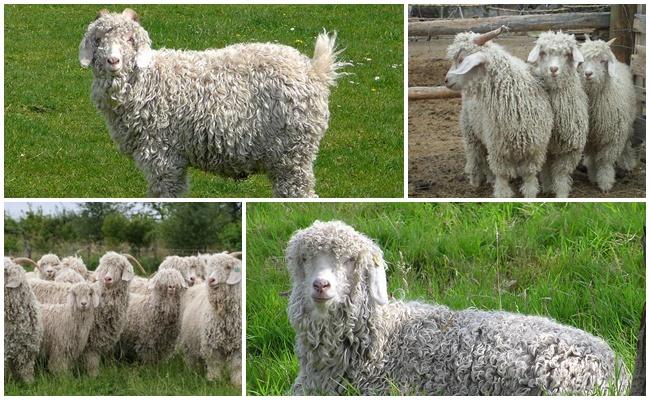
The downy ones include Kyrgyz, Uzbek, Volgograd, Kashmir. There is also a mountain-Altai breed with a black awn and a monochromatic dark gray down. Representatives of this type also have a light color. The animals are also bred to produce wool, which is used in the knitwear and textile industries.
Mixed type
Most often, mixed goats are raised in personal subsidiary plots, from which they receive milk, meat, wool and skins. These are mestizo, that is, animals obtained from different breeds (woolen, down, dairy). They have medium length wool and large udders. One animal produces up to 350 liters of milk per year.
Dwarf goats
There are also decorative dwarf goats that look like young kids. They grow up to only 0.5 meters in height (at the withers) and produce about 1 liter of milk per day. The most common are: Cameroon, Nigerian, La Manche and pygmy Nubians.
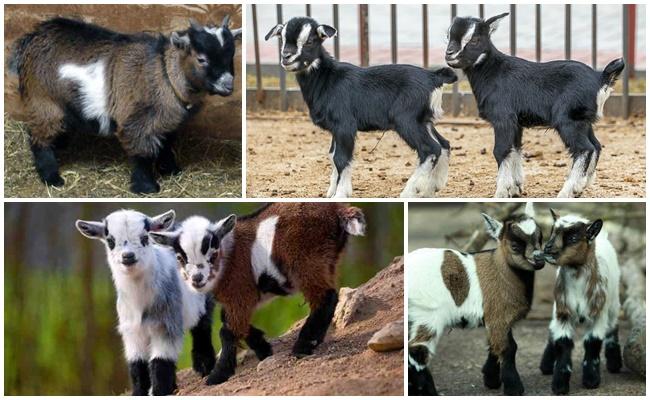
Most popular representatives
In Russia, in rural areas, mainly short-haired goats are raised: Russian, Gorky, Zaanen. These are animals with good immunity, they are adapted to the climate of the middle zone, they begin to milk at the age of 2 years, give 2-4 liters
and milk per day. For the sake of fluff in Russia, they keep Orenburg and near Don long-haired animals. Summer residents often give birth to dwarf decorative goats. Pets belonging to mini-breeds can even live in an apartment.
Recently, local farmers have begun to breed eastern long-eared goats (gulabi, bitaly, camori). These animals have an unusual appearance: long drooping ears. Adult goats weigh about 90 kilograms and produce very tasty, sweet and fatty milk.
How to choose the right goat
An animal is bought for the sake of milk, meat, wool or fluff. Common dairy breeds are best purchased from a local farmer or regular villager. They cost about $ 50-100. Breeding individuals are bought from breeders on special farms. These animals cost from $ 300 and more.
For home breeding, they usually buy a first-calf or goats after 2-3 lambing. Young animals are more productive and get used to a new owner faster.They give the most milk at the age of 5. It is advisable not to buy animals over 7 years old. Milk falls with age. When buying a dairy breed, pay attention to the udder. It should be firm, pear-shaped or bowl-shaped. The udder should not sag and the nipples should not look outward. An asymmetrical shape indicates the effects of mastitis or injury.
The ideal udder has a high position and good attachment. Teats are of medium length, easy to milk. After milking, the udder should fall off and the skin on it should gather in folds. There should not be any seals in the lobes; their presence indicates mastitis.
A healthy goat has a good appetite, it eats greedily, has a barrel-shaped body and a large udder. Dairy breeds have an angular, conical body, meat breeds have a square. Goats that are bred for meat eat a lot, but give little milk. All nutrition is spent on developing muscle mass. Dairy goats have soft and thin wool, while meat goats, on the contrary, have coarse wool.
You can look in the goat's mouth. In sick animals, caries is noticeable on the teeth. The length of the incisors is grinded with age. Older goats have teeth that diverge. Cracks appear between the incisors on the lower jaw. A healthy young goat at the age of 3 years should have 32 teeth in its mouth.
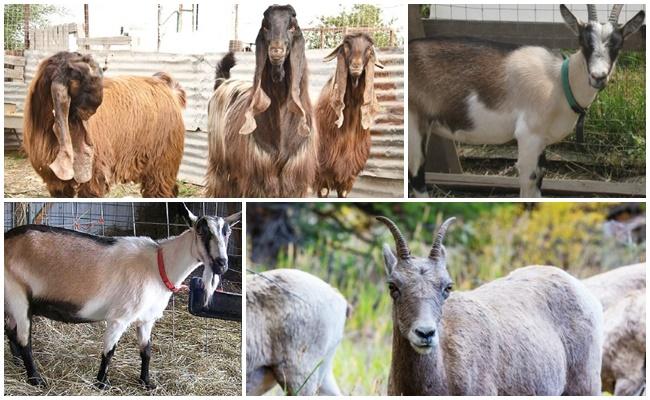
Most often, they do not sell milking goats, but goats at the age of 3-5 months. After all, animals are covered every year to prolong lactation and increase milk yield. Up to 3 months, the kids feed on milk, and then switch to plant foods.
When buying small animals, it is advisable to get to know their mother in order to understand how much milk they will give. True, such goats will be milked only after the first lambing, that is, somewhere in the second year of life. But the health and future productivity of the kids completely depend on the new owner (on the diet and conditions of detention).
When buying downy and woolen goats, first of all, pay attention to the condition of the fluff and wool. Such animals are bought before the start of the haircut and grooming. For example, when buying Orenburg goats, they look at the density of the wool. The down must be at least 5 centimeters long. The best representatives of this breed have their entire body covered with wool. The legs of the Orenburg goats should be straight, the hooves - large, shiny, the body - barrel-shaped in shape. When choosing an animal of any breed, criteria such as age, dental health and udder shape are taken into account.

